Categories > Guides and Tips

20 Delicious Thai Fruits You Have To Try
- Mango
- Best Ways to Enjoy Thai Mangoes
- Mangosteen
- Best Ways to Enjoy Thai Mangosteen
- Rambutan
- Best Ways to Enjoy Thai Rambutan
- Lychee
- Best Ways to Enjoy Thai Lychees
- Durian
- Best Ways to Enjoy Thai Durian
- Jackfruit
- Best Ways to Enjoy Thai Jackfruit
- Tamarind
- Best Ways to Enjoy Thai Tamarind
- Passion Fruit
- Best Ways to Enjoy Thai Passion Fruit
- 9 Pineapple
- Best Ways to Enjoy Thai Pineapples
- Papaya
- Best Ways to Enjoy Thai Papaya
- Dragon Fruit
- Best Ways to Enjoy Thai Dragon Fruit
- Guava
- Best Ways to Enjoy Thai Guava
- Pomelo
- Best Ways to Enjoy Thai Pomelo
- Rose Apple
- Best Ways to Enjoy Rose Apples
- Longkong
- Best Ways to Enjoy Longkong
- Coconut
- Best Ways to Enjoy Coconuts
- Banana
- Best Ways to Enjoy Bananas
- Watermelon
- Best Ways to Enjoy Watermelons
- Plum Mango
- Best Ways to Enjoy Thai Plum Mangoes
- Thai Tangerine
- Best Ways to Enjoy Thai Plum Mangoes
- FAQs about Thai Fruits
Tropical countries are known to have different kinds of fruits all for their inhabitants to enjoy. Thailand is no different and its warm climate and fertile landscape are home to some of the most bountiful fruit harvests across the globe.
Some of the most delicious Thai fruits include common ones like mangoes, dragon fruits, and bananas, and exotic ones like durian and sala, among others.
The combination of Thailand’s tropical climate and fertile plains makes it an ideal growing spot for some of the most exotic and in-demand fruits.
Aside from being delicious, these fruits offer their fair share of health and nutritional benefits. In this article, let’s take a look at some of the most delicious and healthy Thai fruits that everyone should try.
1. Mango
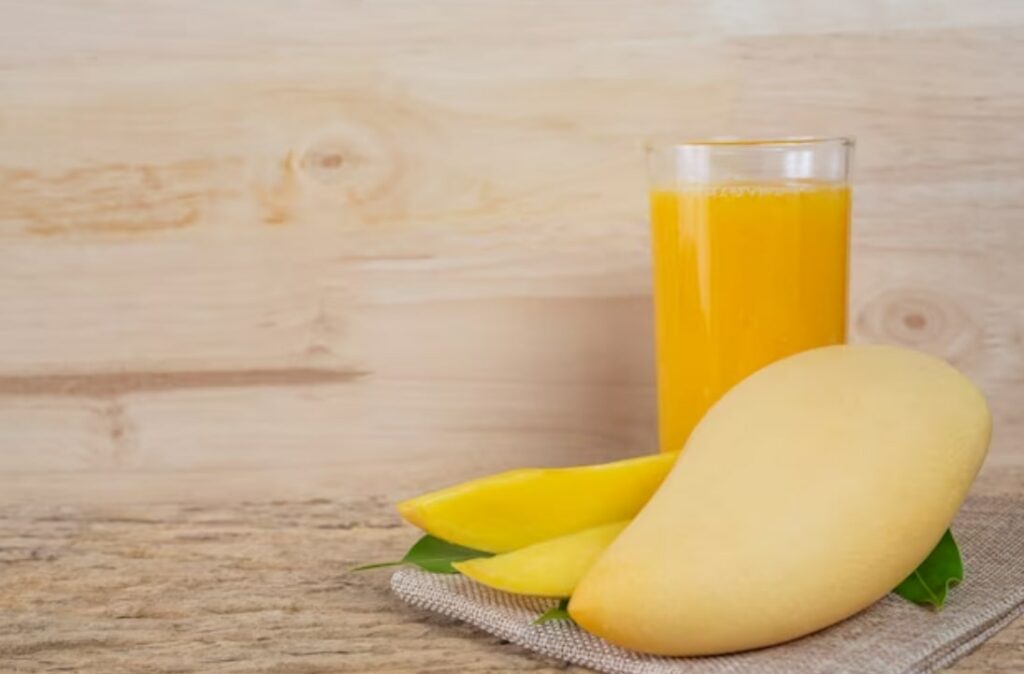
| Thai Name | Ma-Muang |
| Season Availability | March to June |
| Nutrients | Vitamin C and Antioxidants |
One of the most famous fruits in Thailand is the humble but ubiquitous mango also known as Ma-Muang. This fruit is so popular in the country that it forms part of the culture and cuisine of Thailand such as savoury dishes and sweet desserts.
Thailand grows around 200 varieties of mangoes but the main types include Kiew Savoey, Ok Rhong Damnoen, and Nam Dok Mai. Ripe mangoes generally have an aromatic fruit that is tender and sweet.
Unripe mangoes, on the other hand, usually have a tart taste and a chewy texture. Mangoes can usually be eaten raw, as fresh juice, as a fruit shake, or with some sticky rice for dessert.
Best Ways to Enjoy Thai Mangoes
Green mangoes can be used for curry dishes and certain types of salads. Thailand’s mango season typically runs from the month of March to June.
Mangoes contain nutrients that support skin and eye health aside from positively contributing to a healthy diet. The fruit also contains Vitamin C, Antioxidants, and fibre which can help combat inflammatory diseases and improve overall immunity.
2. Mangosteen
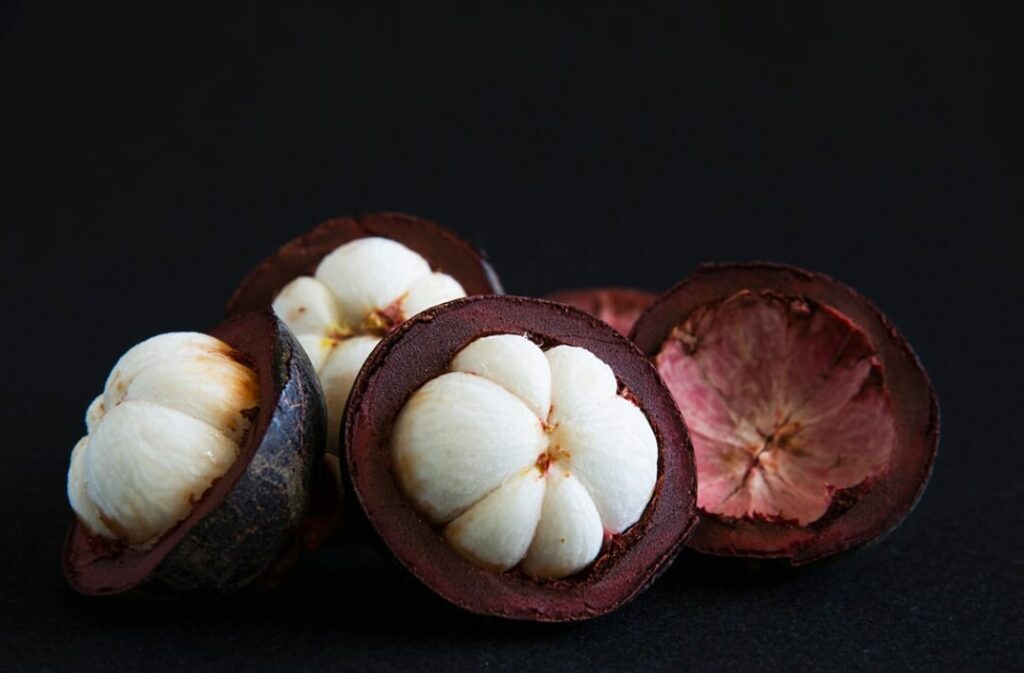
| Thai Name | Mang-Kut |
| Season Availability | April to September |
| Nutrients | Magnesium, Copper, Manganese, Vitamin B2, Vitamin B9, Vitamin B1, and Vitamin C |
Known as Mang-Kut in Thailand, mangosteen has white fleshy fruit inside with a unique purple colour. It is also Thailand’s official national fruit.
Thais refer to the mangosteen as the queen of fruits because it is delicious and at the same time beautiful. However, the purple colour of its skin has been notorious for staining the clothes of people who hold them close to any piece of clothing.
Mangosteen season in Thailand usually runs from the month of April to September.
Best Ways to Enjoy Thai Mangosteen
This fruit can be added to ice creams and smoothies or served as fresh juice, and eaten as is. In addition, mangosteen also has a number of key health benefits and is loaded with nutrients and antioxidants.
Mangosteen contains magnesium, copper, manganese, vitamin B2, vitamin B9, vitamin B1, and Vitamin C which contribute to a healthy and nutritious diet. The fruit is also known to be rich in antioxidants which can protect the body against free radicals.
3. Rambutan
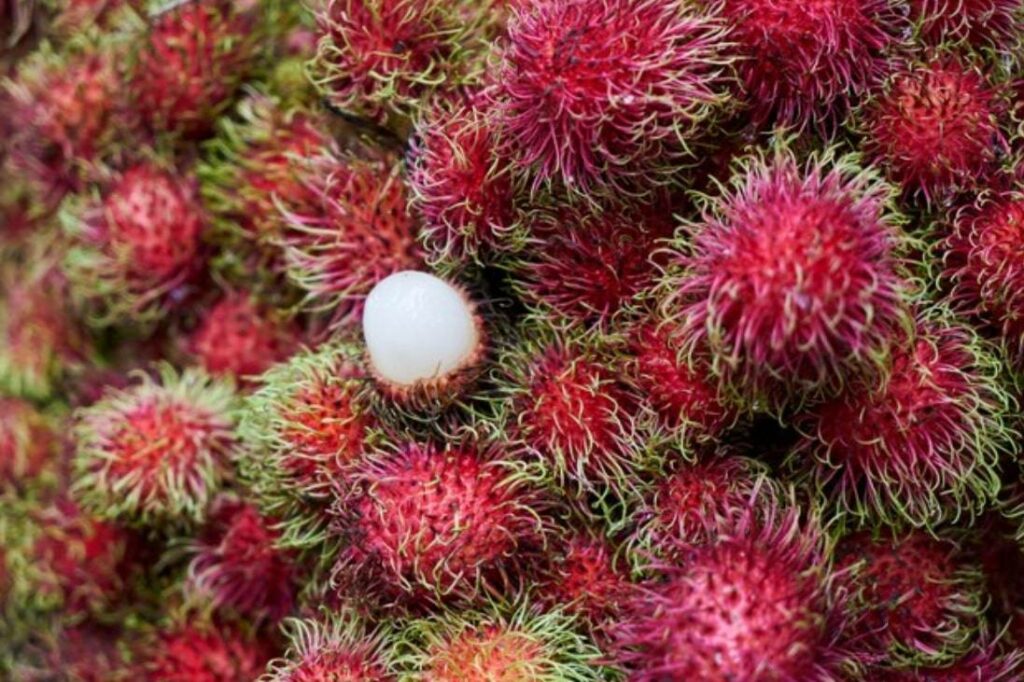
| Thai Name | Ngor |
| Season Availability | April to September |
| Nutrients | Folate, Potassium, and Vitamin C |
Rambutan, or Ngor in Thailand, originated from Malaysia, and its Malay name “rambut” actually means “hair”. This perfectly describes the appearance of the fruit as it looks like a small reddish ball with hair or spikes around its body.
The exterior of the rambutan is actually just a thin peel of spines. When these spines are removed, the fruit will reveal its fleshy fruit which covers a seed.
The rambutan’s flavour can resemble that of the lychee or the longan but it is not as sweet or as aromatic. People eating this fruit should also ensure to throw the peels away as these are rather toxic.
Best Ways to Enjoy Thai Rambutan
Rambutan season runs from the month of April to September and this fruit can be enjoyed as fresh juice, a fruit shake, jam, or eaten as is.
This fruit also has key nutrients and health benefits. Rambutan is known to be rich in Folate, a vitamin that is crucial for DNA duplication and healthy cell division.
Rambutans are also rich in Potassium which aids in the healthy function of the muscles, kidneys, and heart. Lastly, rambutan also contains Vitamin C which is a powerful antioxidant that can help reduce the risk of cancer.
4. Lychee
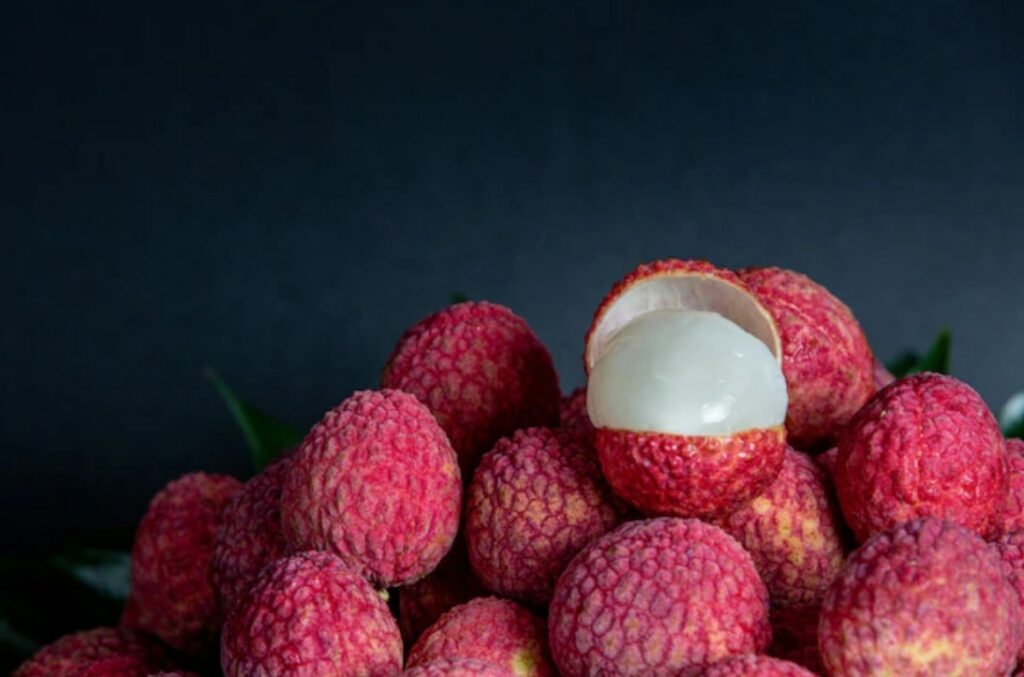
| Thai Name | Lin-jee |
| Season Availability | April to June |
| Nutrients | Rutin, Epicatechin, Vitamin C, Copper, and Potassium |
Lychee is called Lin-jee in Thailand and it has the moniker alligator strawberry. This fruit is covered in bumpy and loose skin and is a white-fleshed fruit that is sweet and floral and covers a black seed.
Other fruits may have similar-looking flesh but lychee has a distinct taste and aroma. This fruit is currently grown across Thailand but it was originally from southeast China.
Lychee season in Thailand covers the months of April to June.
Best Ways to Enjoy Thai Lychees
Locals serve or consume lychee in a variety of different ways. The fruit can be served as a fruit shake, as soda flavouring, as a topping for desserts, as fresh juice, or eaten as is.
Aside from its unique taste, lychee has a number of nutritional and health benefits such as the reduction of several chronic diseases and the fight against certain cancers such as cancer of the liver.
In addition, Lychee contains certain nutrients and antioxidants that can contribute to overall health. These include rutin, epicatechin, vitamin C, copper, and potassium, all of which can help prevent diabetes, cancer, and heart disease.
5. Durian
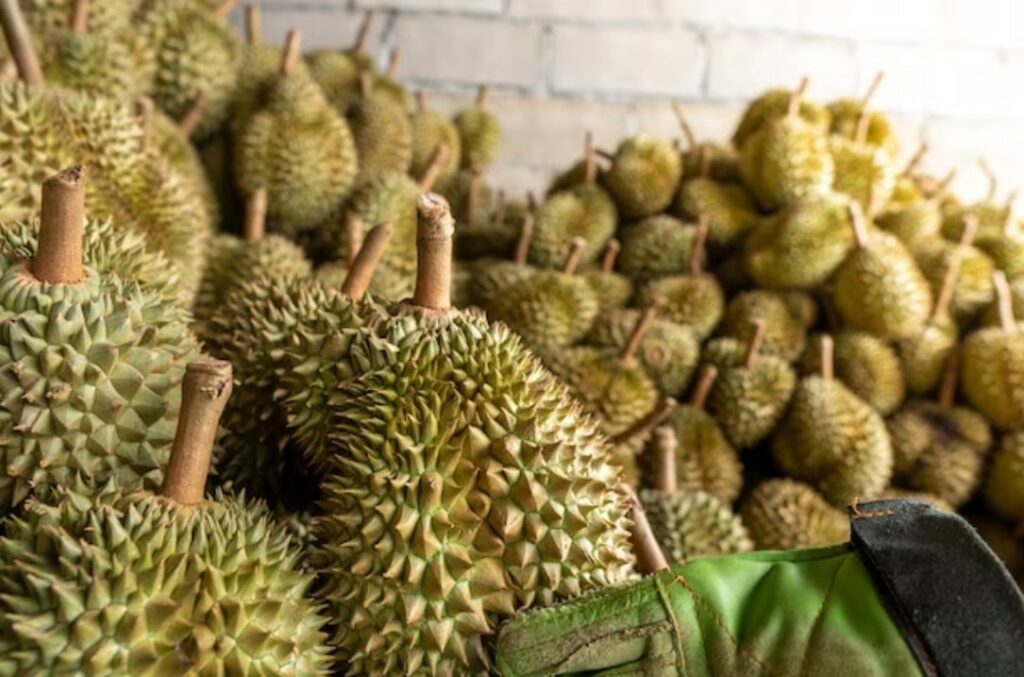
| Thai Name | Tu-rian |
| Season Availability | April to August |
| Nutrients | Niacin, Magnesium, Folate, Copper, Riboflavin, Potassium, and Vitamin B6. |
If the mangosteen is the queen of fruits, then Durian, or Tu-rian in Thailand, is recognized as the king of fruits. However, this fruit either has a love-it or hate-it reputation among those who already tasted it.
The edible lobes of this fruit are encased in a spiky exterior. The said lobes of the durian, though, reek of an odour that can only be described as a cross between seeping sewage and rotten green onions.
People who can get over this deathly smell can enjoy the online-like and creamy flavour of this fruit during the durian season in Thailand which runs from April to August.
Best Ways to Enjoy Thai Durian
Durian is also quite versatile and can be served with sticky rice and added to sticky rice, fruit shakes, ice cream, chips, and eaten raw.
The fruit may have that distinct odour but its health benefits are undeniable. It contains some of the most essential nutrients for good health which include Niacin, Magnesium, Folate, Copper, Riboflavin, Potassium, and Vitamin B6.
This smelly tropical fruit has also been known to lower blood sugar, fight infections, prevent heart disease, and lower the risk of certain cancers.
6. Jackfruit

| Thai Name | Khanoon |
| Season Availability | Available all year round |
| Nutrients | Manganese, Copper, Potassium, Magnesium, Riboflavin, Vitamin A, and Vitamin C |
Also called Khanoon by Thais, the Jackfruit is one big fruit that can weigh as much as 50 pounds and grow up to three feet in length. Its exterior can be likened to that of the durian but it is not as spiky.
The jackfruit’s edible portions are quite fleshy and they cover the fruit’s seeds. Interestingly, the flesh of this fruit has been compared to that of chicken meat when boiled thanks to its stringy texture.
Best Ways to Enjoy Thai Jackfruit
Hence, jackfruit is commonly used as an alternative to meat for savoury cuisines. The fruit’s tropical flavour is heightened as the fruit matures together with its aroma which can become off-putting and more intense.
The good news for alternative chicken meat lovers is that jackfruit grows in Thailand all year long. This means that anyone can enjoy this fruit anytime, especially when added to ice creams, used as a meat substitute, or eaten as is.
In addition to being delicious and available all year long, Jackfruit can offer some potential health benefits to fruit lovers. Some of its health benefits include better control of blood sugar, protection against chronic inflammation, and improved cardiac health.
Jackfruit also has an impressive nutritional profile which includes Manganese, Copper, Potassium, Magnesium, Riboflavin, Vitamin A, and Vitamin C. Aside from these nutrients, the fruit offers a good amount of fibre to round up an overall healthy diet.
7. Tamarind

| Thai Name | Ma Kam |
| Season Availability | December to February |
| Nutrients | Iron, Magnesium, Calcium, Potassium, Vitamin A, Vitamin C, Folate, and Niacin |
Tamarind is known as Ma Kam in Thailand and is an important part of the country’s culinary culture. Its versatile flavour and aroma allow locals to use it in desserts and savoury dishes.
The fruit has a hard exterior and resembles a pod of beans. Once the exterior is peeled, the interior will reveal a fibrous and sticky flesh that surrounds the core of the fruit.
The tamarind’s edible portion is toffee-like and sticky. It has also been described to have a sweet and tart flavour that can be likened to a sour caramel.
Tamarind season runs from the end of the year (December) to February.
Best Ways to Enjoy Thai Tamarind
As mentioned earlier, tamarind can be quite versatile. Thais use it for candies, dipping sauces, soups like Tom Yum, and stir-fry dishes such as the local favourite, Pad Thai.
Aside from being versatile, tamarind can also provide a number of health benefits. These include preventing certain cancers, better cholesterol control, improved heart health, protection for the liver, and key antimicrobial benefits.
Tamarind also offers a slew of beneficial nutritional components. These include Iron, Magnesium, Calcium, Potassium, Vitamin A, Vitamin C, Folate, and Niacin.
8. Passion Fruit
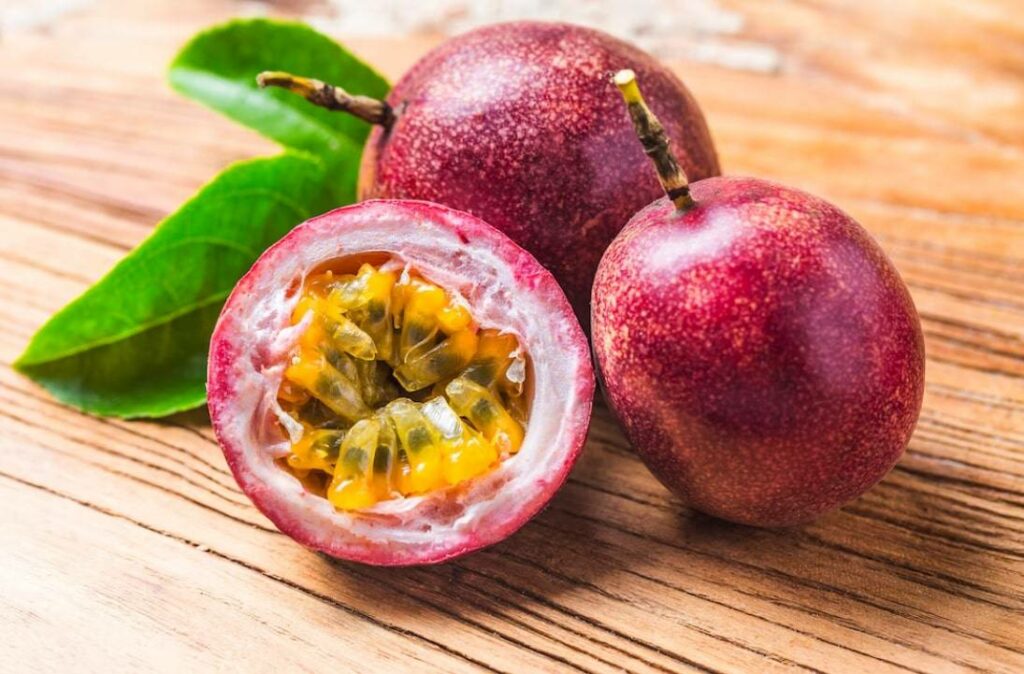
| Thai Name | Saowarot |
| Season Availability | Available all year round |
| Nutrients | Iron, Calcium, Vitamin C, Magnesium, Potassium, and Vitamin A |
Saowarot is the Thail name of passion fruit but it is not originally from Thailand. This fruit originally came from South America but due to its perfect blend of sour and sweet flavours, Thais embraced this fruit like their own.
Best Ways to Enjoy Thai Passion Fruit
This fruit is mostly used in fun and refreshing beverages due to its jelly-like interior. This flesh of the passion fruit has an aroma that can be described as citrusy and is the most prized part of this fruit.
Thai Fruit markets sell these fruits in varying colours which include green, yellow, and purple. When eaten as is, the seeds of the fruit can be quite annoying but are considered edible and can even provide a texture that is nice and crunchy.
While originally from South America, passion fruit is available all year round in Thailand. Aside from its availability, this fruit also has some impressive health benefits.
Passion fruit has been shown to reduce blood sugar levels, improve insulin sensitivity, enhance the immune system, and lower anxiety. In addition, the fruit also provides key nutrients such as Iron, Calcium, Vitamin C, Magnesium, Potassium, and Vitamin A.
9 Pineapple
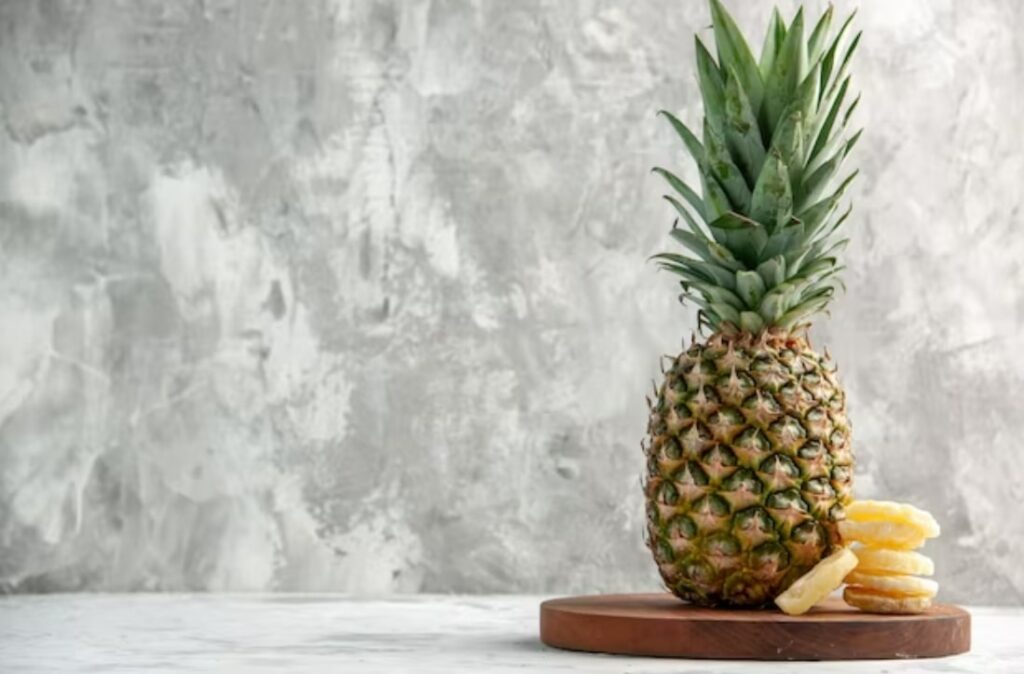
| Thai Name | Sapparot |
| Season Availability | October to June |
| Nutrients | Iron, Riboflavin, Pantothenic Acid, Niacin, Magnesium, Potassium, Folate, Thiamine, Copper, and Vitamin B6 |
Popular not just in Thailand but also the world over, Pineapple is known to locals as Sapparot. This refreshing fruit is considered a healthy and delightful snack due to its sweet and tart flavour.
Their global popularity can also be attributed to how easy they are to ship. The fruit’s interiors are protected by a tough exterior and an inedible inner core.
One thing to remember when eating a pineapple though is that the fruit contains bromelain, an enzyme that can break down tissues. Consuming a lot of pineapples can lead to soreness on the roof of the mouth and gums.
Pineapples are available and in season in Thailand from the month of October to June.
Best Ways to Enjoy Thai Pineapples
Due to their tart and sweet flavour, pineapples can be served and added to a variety of different dishes. These include desserts, fresh juices, fruit shakes, and savoury dishes like fried rice infused with pineapple.
Of course, its popularity isn’t only about its taste but also the pineapple’s health benefits. These benefits include improved digestion, prevention of certain cancers, enhanced immunity, and reduced inflammation.
Pineapple also has a healthy nutritional profile as it can provide vitamins and minerals crucial for good health. Examples of these nutrients are Iron, Riboflavin, Pantothenic Acid, Niacin, Magnesium, Potassium, Folate, Thiamine, Copper, and Vitamin B6.
10. Papaya
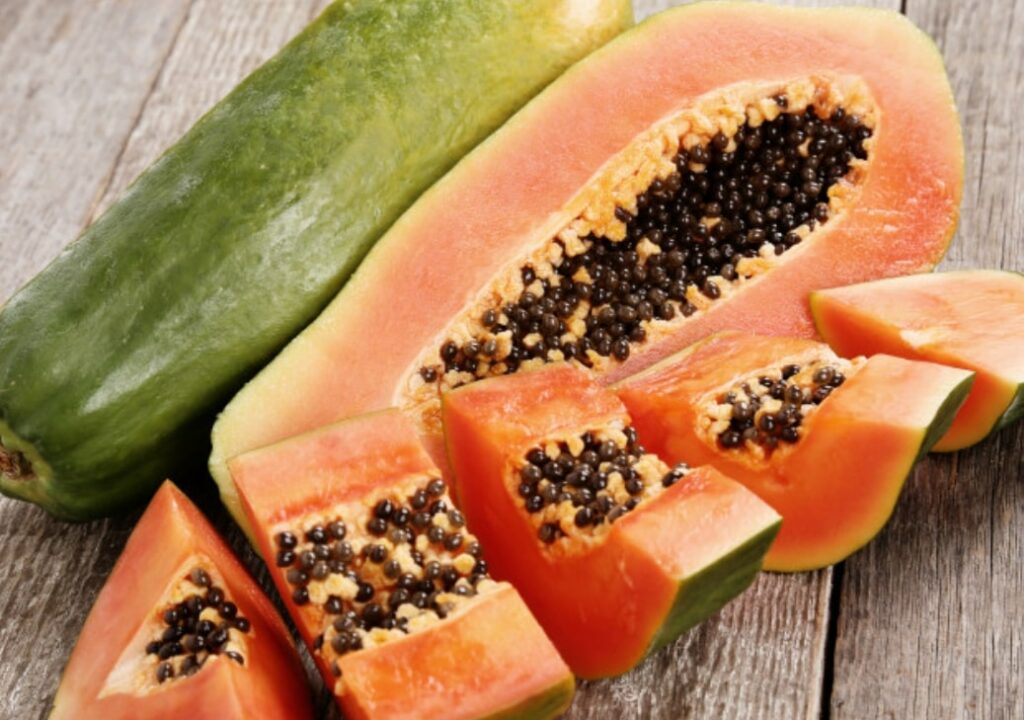
| Thai Name | Malagor |
| Season Availability | Available all year round |
| Nutrients | Vitamin C, Iron, Vitamin B6, Magnesium, Calcium, Vitamin D, and Cobalamin |
Thais call the papaya Malagor and locals usually eat this fruit while it is still unripe. This is quite surprising as perfectly ripe papaya will usually taste delicious and sweet.
Best Ways to Enjoy Thai Papaya
The unripe green papaya is usually sliced into thin strips to come up with Tom Sam, a classic salad dish from the country’s northeastern part. The papaya is also quite abundant in eastern and southern Thailand.
Once the papaya is ripe, a cut right in the middle of the fruit will grant access to the orange flesh of the fruit. It will also reveal the chamber that contains tons of black seeds that are nutritious but bitter to the taste.
Some of the papaya’s health benefits include strengthening the immune system, aiding digestion, and reducing inflammation. These are mostly due to its nutritional content such as Vitamin C, Iron, Vitamin B6, Magnesium, Calcium, Vitamin D, and Cobalamin.
11. Dragon Fruit
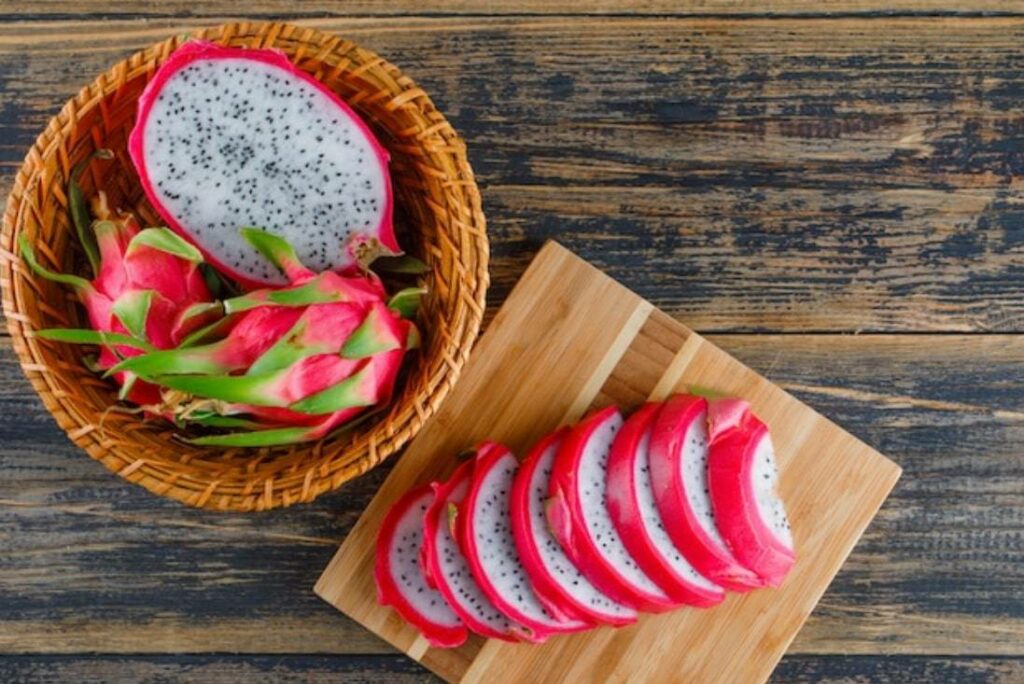
| Thai Name | Gao Mung Gorn |
| Season Availability | Available all year round |
| Nutrients | Vitamin E, Vitamin C, Magnesium, Iron, Betacyanins, Carotenoids, and Polyphenols |
Also called Gao Mung Gorn in Thailand, the dragon fruit is part of the cactus family known as Pitaya. This fruit may be strange looking with wing-like shoots that come off to the sides and top.
The edible interior of the dragon fruit is either purple or white with a lot of tiny seeds that are a bit bigger than poppy seeds. A rare version of dragon fruit also has a white edible interior and a yellow exterior.
Best Ways to Enjoy Thai Dragon Fruit
The dragon fruit is not as popular as the sweet pineapple or mango. Its flavour is relatively mild compared to the other fruits but it’s still a highly sought-after fruit thanks to its unique look and year-round availability.
Dragon fruits have been reported to fight chronic diseases such as diabetes and cancer. It also aids in the promotion of a healthy gut, enhances the immune system, and boosts low levels of iron.
This fruit also contains essential vitamins and minerals such as Vitamin E, Vitamin C, Magnesium, Iron, and fibre. Dragon fruit also contains plant compounds that are beneficial such as Betacyanins, Carotenoids, and Polyphenols.
12. Guava
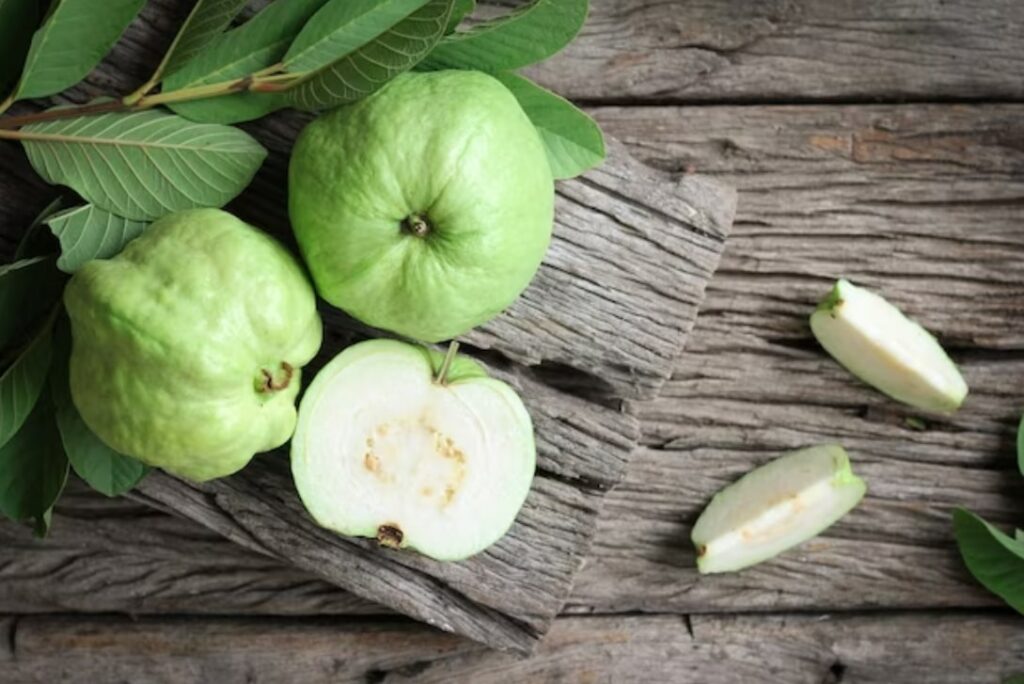
| Thai Name | Farang |
| Season Availability | Available all year round |
| Nutrients | Potassium, Vitamin C, and Antioxidants |
Guava or Farang in Thailand is not native to Thailand. It was originally grown in the south and central Americas but is now being grown not just in Thailand but in many different countries with tropical climates.
The fruit was originally brought by the Portuguese and the name “Farang” is actually the slang word for “foreigner”. After being transported to Thailand, the guava fruit has since thrived in the country as it is available all year round.
Best Ways to Enjoy Thai Guava
The fruit is highly sought-after, though, as the unripe and ripe iteration of the guava can give off different aromas which can be used for different local dishes. One example is when the unripe guava is dipped into a chilli and sugar mixture and added to salads.
The humble guava fruit may look unassuming but it can offer a plethora of health benefits. It has been reported to reduce the levels of blood sugar, boost cardiac health, relieve menstrual pain, aid the digestive system, and contribute to weight loss.
Guavas are also rich in fibre, Potassium, Vitamin C, and Antioxidants.
13. Pomelo
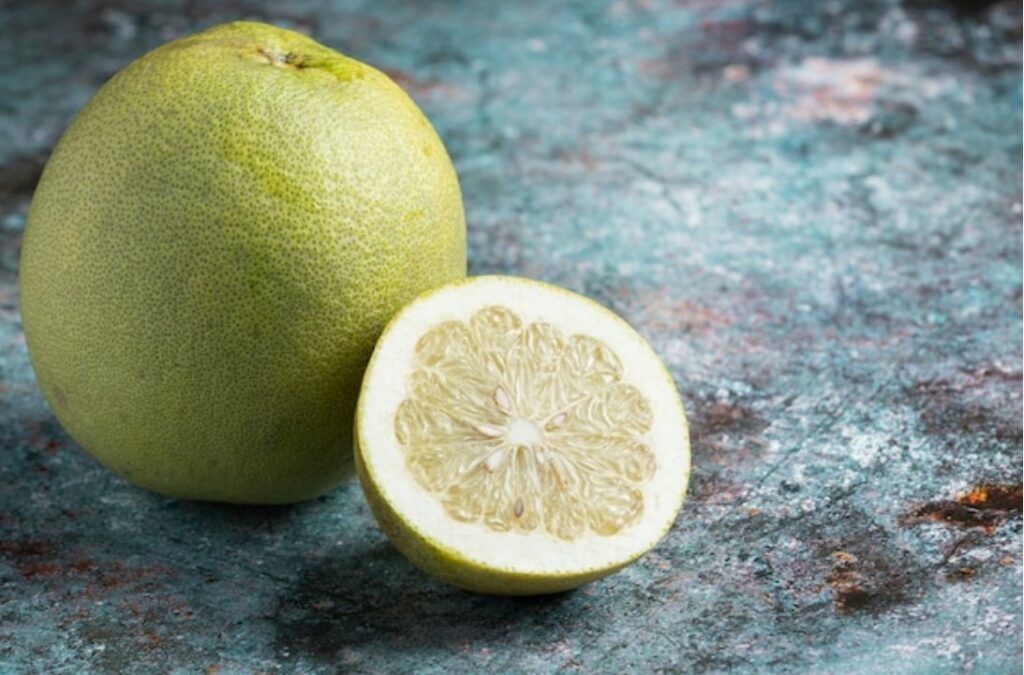
| Thai Name | Som-o |
| Season Availability | March to April and August to November |
| Nutrients | Potassium, Copper, Vitamin C, Thiamine, and Riboflavin |
To the Thais, the pomelo is locally known as Som-o. This fruit can be described as a larger jack fruit and can weigh up to 4 pounds and can get up to a foot in diameter.
Pomelo is quite popular in Thailand, especially when it is in season. This is mainly because of the fruit’s acidic, bitter, and sweet flavours which all balance each other out.
Portions of the pomelo that have been cleaned off can be purchased from fruit vendors across Thailand which are usually sold in individually packed containers. This is mainly due to the difficulty of peeling the fruit’s exterior and getting to its edible flesh.
Fortunately, pomelo lovers don’t have to wait for just one season as the fruit is available or in its season twice a year. The first pomelo season occurs from March to April while the second one occurs around the months of August to November.
Best Ways to Enjoy Thai Pomelo
The fruit can be eaten raw or as is. However, locals usually use pomelo in the preparation of certain salads like the Tam Sam- O Nam Pu.
Eating pomelo as part of a healthy diet can also help individuals achieve better health. This is because of the fruit’s impressive health benefits which include weight loss, enhanced cardiac health, anti-aging, and reduced risk for certain cancers.
These health benefits are supported by the nutrients present in pomelo. The fruit provides Potassium, Copper, Vitamin C, Thiamine, and Riboflavin, all of which contribute to a healthier diet.
14. Rose Apple
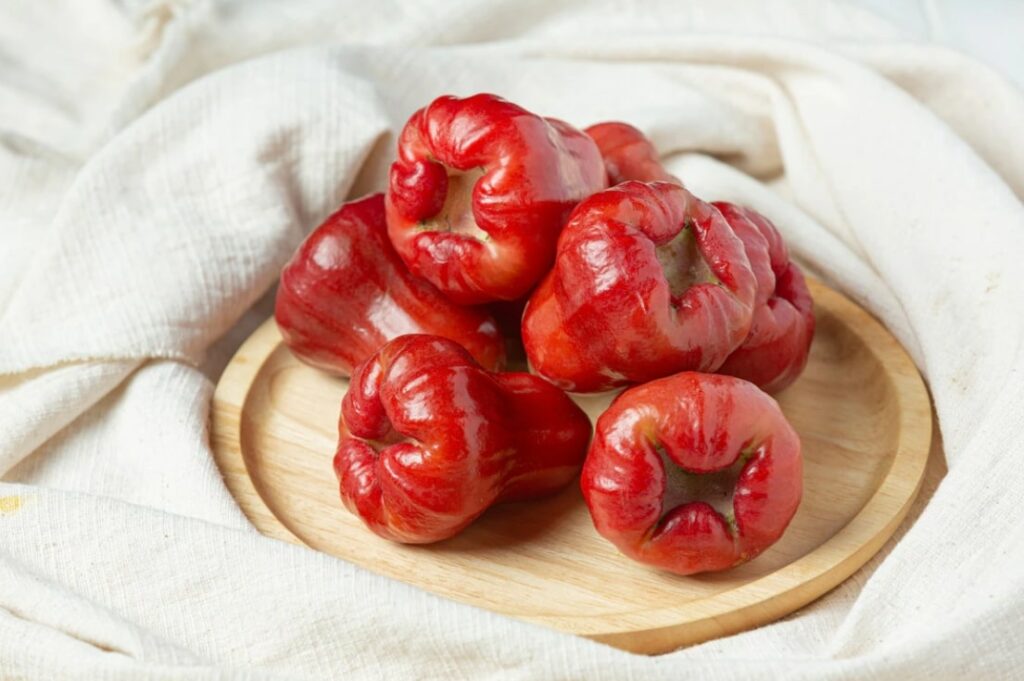
| Thai Name | Chom-poo |
| Season Availability | Available all year round |
| Nutrients | Vitamin C, Vitamin A, Iron, Calcium, and Protein |
The Chom-poo or Rose Apple fruit is neither an apple nor a rose. It’s a local tropical fruit found in various parts of Southeast Asia.
The Rose Apple is crunchy but it is not as tender as a watermelon and less fibrous than an apple. However, the flesh of this fruit is quite delicious and delicate.
Best Ways to Enjoy Rose Apples
The flavour has also been described as being quite juicy and reminiscent of sweet pepper with a hint of floral or rose scent. Fortunately, this fruit is available year-round and can be enjoyed as is.
Studies suggest that eating rose apples can provide individuals with some important health benefits. There is data that shows how rose apples can help improve skin health, boost immunity, cleanse the kidney and liver, manage diabetes, and aid in digestion.
Moreover, rose apples can provide key nutrients for good health. These include Vitamin C, Vitamin A, Iron, Calcium, fibre, and Protein.
15. Longkong
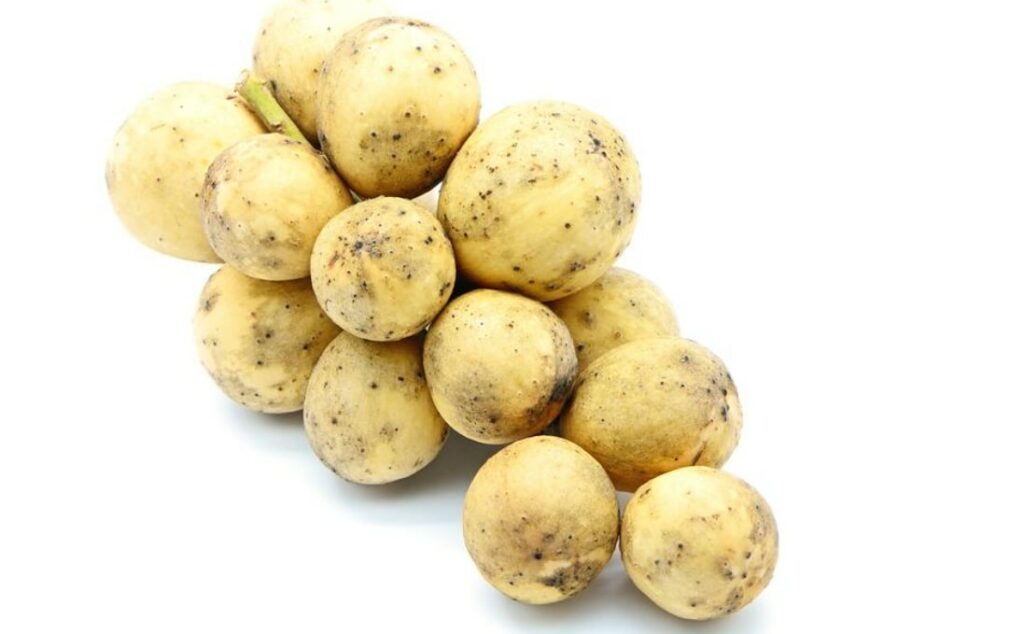
| Thai Name | Lang-sard |
| Season Availability | July to October |
| Nutrients | Potassium, Phosphorus, and Calcium |
Referred to by locals as Lang-sard, this local fruit can look like butterball potatoes that grow in clusters just like grapes. It has a bitter seed surrounded by white tender flesh.
The said longkong fruit flesh can be separated into different segments and will look like peeled pieces of translucent garlic. Thais love this fruit for its sweet and tart flavour which can be described as being a cross between a green grape and a grapefruit.
Best Ways to Enjoy Longkong
This fruit is eaten as is or eaten raw and is only in season in Thailand from the months of July to October.
Longkong fruits can also provide some health benefits despite their small size. These include reducing inflammation, lowering fevers, improving immunity, and repairing the skin.
The fruit also contains minerals that can contribute to overall health. Some of these minerals are Potassium, Phosphorus, and Calcium.
16. Coconut

| Thai Name | Ma-Praow |
| Season Availability | Available all year round |
| Nutrients | Potassium, Iron, Phosphorus, Magnesium, Selenium, Copper, and Manganese |
Coconuts, also known as Ma-Praow in Thailand, are a core part of Thai cuisine. They are consumed for their white flesh, juice, and coconut oil extracted from the fats of the fruit.
This fruit is used in a lot of Thai dishes and beverages. Some examples include fruit shakes, candies, desserts, hydrating juices, ice cream, and as soup and curry bases.
Fortunately, coconuts are in season for the entire year and they can be bought or purchased just about anywhere in Thailand.
Best Ways to Enjoy Coconuts
Aside from being used in a lot of Thai dishes, locals love coconuts for the impressive health benefits they can provide. Coconuts have been shown to have antibacterial properties, antioxidants, and high fibre and fat content which can help control diabetes.
In addition, coconuts are highly nutritious and can provide minerals such as Potassium, Iron, Phosphorus, Magnesium, Selenium, Copper, Manganese, and fat.
17. Banana
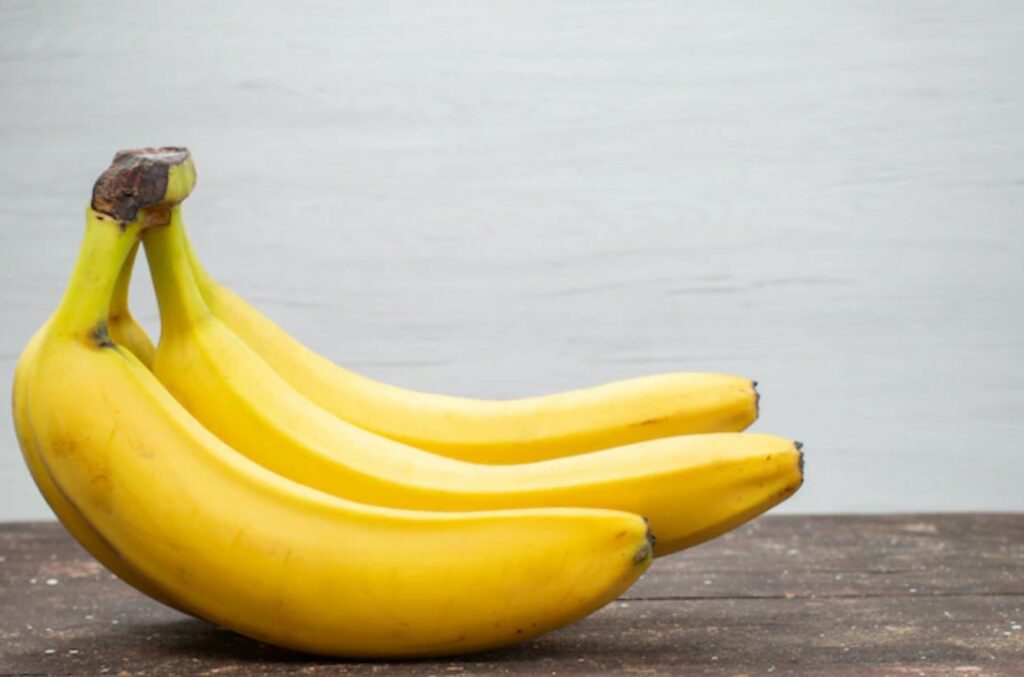
| Thai Name | Gluay |
| Season Availability | Available all year round |
| Nutrients | Magnesium, Potassium, Copper, Niacin, Folate, Riboflavin, and Vitamin C |
Who isn’t familiar with Gluay or bananas? These fruits are one of the most common and available fruits not just in Thailand but across the globe as they can be transported unripe (green), turn yellow (ripe) in transit, and be sold in stores without any problems.
Amazingly, bananas in Thailand can simply be taken from the plant where they are growing before they ripen or turn yellow. In addition, the bananas in Thailand are so varied that these different varieties can range from short and stubby to fluffy and sweet.
Best Ways to Enjoy Bananas
Bananas grow all year round in Thailand and they can be served blended into fruit shakes and as dessert items such as deep-fried or grilled bananas.
On top of their year-round availability, bananas also offer some impressive health benefits. Some of these benefits are improved blood sugar levels, enhanced digestion, faster weight loss, and improved cardiac health.
Bananas are also rich in nutrients as they contain Magnesium, Potassium, Copper, Niacin, Folate, Riboflavin, and Vitamin C.
18. Watermelon
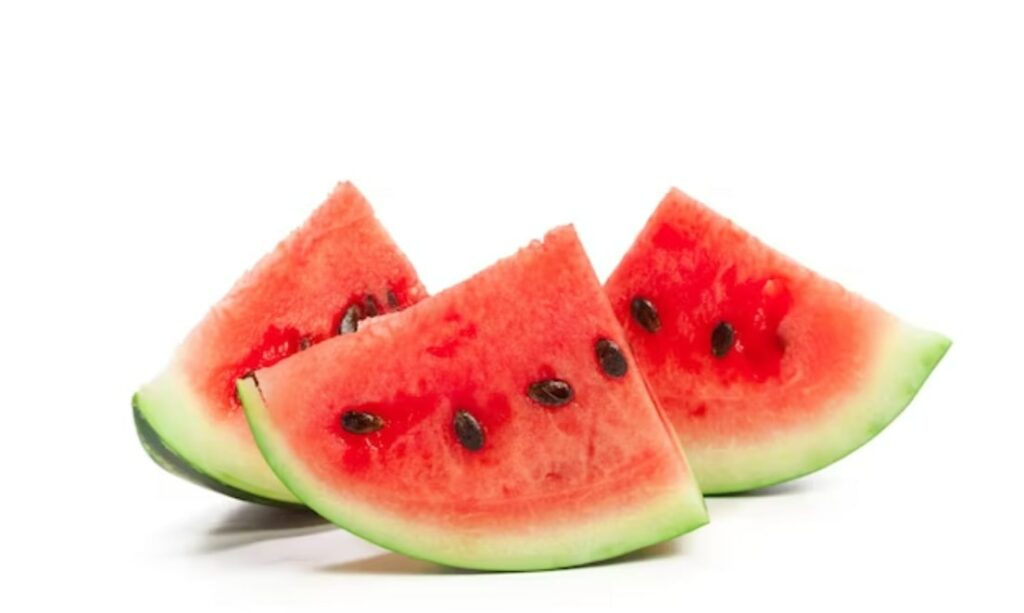
| Thai Name | Tengmo |
| Season Availability | Available all year round |
| Nutrients |
Thailand is in love with its Tengmo or watermelon as these fruits are a great way to beat the summer heat in this tropical country. The good news is it’s not just grown during summer as the watermelon is available all year round.
Watermelon varieties available in other parts of the globe are the ones being sold in Thailand as well. These include the less sweet yellow-fleshed type and the more common red watermelons.
However, the seedless varieties mainly sold in the West are not commonly sold in Thailand.
Best Ways to Enjoy Watermelons
Watermelons are usually just eaten raw, served as fresh juice or used in the preparation of fresh shakes.
Aside from being refreshing, this delicious fruit can also help fight off cancer, improve cardiac health, reduce oxidative stress and inflammation, and relieve soreness of the muscles.
This fruit can also provide a variety of nutrients for good health such as Magnesium, Potassium, Vitamin C, and Vitamin A. Watermelons also contain Antioxidants such as Cucurbitacin E, Lycopene, and Carotenoids.
19. Plum Mango

| Thai Name | Ma-Prang |
| Season Availability | February to May |
| Nutrients | Vitamin C, Niacin, Thiamine, and Riboflavin |
The plum mango, Marian plum, or Ma-Prang in Thailand, is referred to as a mini mango. This is because the flavour of this fruit has been likened to that of a mango mixed with some persimmon and with the texture of a plum.
While the seed of this fruit is quite bitter and should not be eaten, the other parts of the fruit are edible including the skin. Thai vendors sell these fruits according to quality and weight but they are mostly displayed in their natural state.
Best Ways to Enjoy Thai Plum Mangoes
This fruit can be enjoyed from the months of February to May and is usually served mixed in salads and fruit shakes or eaten as is.
This delicious tropical fruit also packs some unexpected health benefits. Studies suggest that the plum mango can be great for skin health, iron absorption, cancer prevention, lung health, cardiac health, and diabetes management.
A 100-gram serving of this fruit can also provide minerals such as phosphorus, iron, and calcium along with vitamins such as Vitamin C, Niacin, Thiamine, and Riboflavin.
20. Thai Tangerine
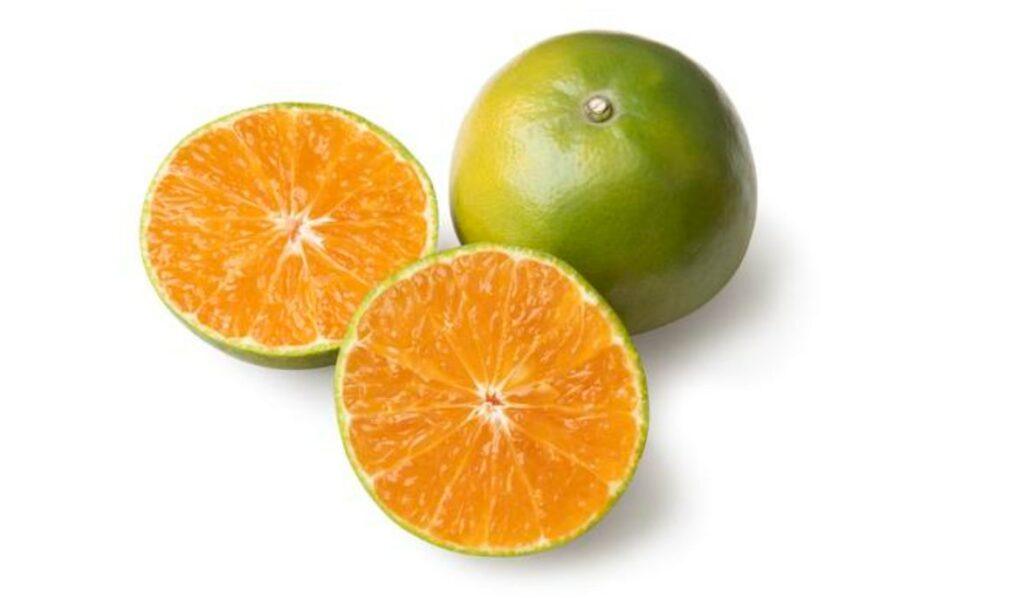
| Thai Name | Bang Mot |
| Season Availability | September to February |
| Nutrients | Potassium, Vitamin A, and Vitamin C |
Referred to as Bang Mot by locals, the Thai Tangerine is considered a mandarin. This fruit is a local favourite since it has that perfect balance of acidity and sweetness.
One of the best things about the Thai Tangerine is its very affordable price, especially during the Bang Mot season which runs from the months of September to February.
Best Ways to Enjoy Thai Plum Mangoes
These fruits are commonly eaten raw but they can also be served as juice.
Most foreigners may assume that the green colour of the fruit means it is still unripe but despite the fruit’s skin colour, it is actually ready for consumption. The Thai Tangerine’s seeds should be avoided though as they can be quite bitter when cracked.
Thai Tangerines may be cheap but they can provide a number of health benefits. These include improved brain health, enhanced immunity, improved skin health, and enhanced cardiac health.
On top of this, these fruits can boost health through the provision of certain nutrients such as Potassium, Vitamin A, and Vitamin C.





